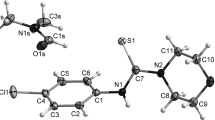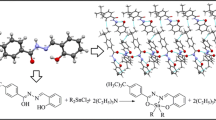Abstract
In this paper, a new organic–inorganic hybrid compound [Co(L)2]2[W6O19](1) (HL = 2-acetylpyridine thiosemicarbazone) was prepared and characterized. The compound 1 exhibits remarkable antibacterial activity by determination of minimum inhibitory concentration (MIC) against Staphylococcus aureus (S. aureus, 0.06 µg·mL−1) and Escherichia coli (E. coli, 0.24 µg·mL−1), respectively. Furthermore, the potential mechanism of compound 1 was studied in detail. The potential causes of bacteria death were cell wall/membrane disruption, inhibition of intracellular respiratory chain dehydrogenases (RCD) activity, destruction of reactive oxygen species (ROS) and depletion of glutathione (GSH).








Similar content being viewed by others
Change history
21 August 2021
A Correction to this paper has been published: https://doi.org/10.1007/s42864-021-00115-4
References
Jones KE, Patel NG, Levy MA, Storeygard A, Balk D, Gittleman JL, Daszak P. Global trends in emerging infectious diseases. Nature. 2008;451(7181):990.
Huedo C, Zani F, Mendiola A, Pradhan S, Sinha C, López-Torres E. Synthesis, antimicrobial activity and molecular docking of di- and triorganotin (IV) complexes with thiosemicarbazide derivatives. Appl Organometal Chem. 2019;33:e4700.
Bijelic A, Aureliano M, Rompel A. The antibacterial activity of polyoxometalates: structures, antibiotic effects and future perspectives. Chem Commun. 2018;54(10):1153.
She S, Bian ST, Hao J, Zhang JW, Zhang J, Wei YG. Aliphatic organoimido derivatives of polyoxometalates containing a bioactive ligand. Chem Eur J. 2014;20(51):16987.
Saad A, Zhu W, Rousseau G, Mialane P, Marrot J, Haouas M, Taulelle F, Dessapt R, Serier BH, Rivière E, Kubo T, Oldfield E, Dolbecq A. Polyoxomolybdate bisphosphonate heterometallic complexes: synthesis, structure, and activity on a breast cancer cell line. Chem Eur J. 2015;21(29):10537.
Judd DA, Nettles JH, Nevins N, Snyder JP, Liotta DC, Tang J, Ermolieff J, Schinazi RF, Hill CL. Polyoxometalate HIV-1 protease inhibitors. A new mode of protease inhibition. J Am Chem Soc. 2001;123(5):886.
Wong EL, Sun RW, Chung NP, Lin CS, Zhu NY, Che C. A mixed-valent ruthenium-oxo oxalato cluster Na7[Ru4(μ3-O)4(C2O4)6] with potent anti-HIV activities. J Am Chem Soc. 2006;128(15):4938.
Li JF, Chen ZJ, Zhou MC, **g JB, Li W, Wang Y, Wu LX, Wang LY, Wang YQ, Lee M. Polyoxometalate-driven self-assembly of short peptides into multivalent nanofibers with enhanced antibacterial activity. Angew Chem Int Ed. 2016;55(7):2592.
Gonzalez A, Galvez N, Clemente-Leon M, Dominguez-Vera JM. Electrochromic polyoxometalate material as a sensor of bacterial activity. Chem Commun. 2015;51(50):10119.
Misra A, Castillo IF, Muller DP, Gonzalez C, Eyssautier-Chuine S, Ziegler A, de la Fuente JM, Mitchell SG, Streb C. Polyoxometalate-ionic liquids (POM-ILs) as anticorrosion and antibacterial coatings for natural stones. Angew Chem Int Edit. 2018;57:14926.
She S, Bian ST, Huo RC, Chen K, Huang ZH, Zhang JW, Hao J, Wei YG. Degradable organically-derivatized polyoxometalate with enhanced activity against glioblastoma cell line. Sci Rep. 2016;6(1):33529.
Zhao M, Fang Y, Ma LH, Zhu XY, Jiang L, Li MX, Han QX. Synthesis, characterization and in vitro antibacterial mechanism study of two Keggin-type polyoxometalates. J Inorg Biochem. 2020;210:111131.
Du X, Guo C, Hansel E, Doyle PS, Caffrey CR, Holler TP, McKerrow JH, Cohen FE. Synthesis and structure-activity relationship study of potent trypanocidal thio semicarbazone inhibitors of the trypanosomal cysteine protease cruzain. J Med Chem. 2002;45(13):2695.
Khan SA, Kumar P, Joshi R, Iqbal PF, Saleem K. Synthesis and in vitro antibacterial activity of new steroidal thiosemicarbazone derivatives. Eur J Med Chem. 2009;43(9):2029.
Mishra A, Kaushik NK, Verma AK, Gupta R. Synthesis, characterization and antibacterial activity of cobalt(III) complexes with pyridine-amide ligands. Eur J Med Chem. 2008;43(10):2189.
Zhao HY, Li J, Fang Y, Chang BW, Meng QX, Li MX, Wang CZ, Zhu XF. Synthesis, characterization and bioactivities of a new covalent copper(II) compound derived from {P2Mo5O23}6− and thiosemicarbazones. Bioorg Med Chem Lett. 2020;30(1):126781.
Kowol CR, Trondl R, Arion VB, Jakupec MA, Lichtscheidl I, Keppler BK. Fluorescence properties and cellular distribution of the investigational anticancer drug triapine (3-aminopyridine-2-carboxaldehyde thiosemicarbazone) and its zinc(II) complex. Dalton Trans. 2010;39(3):704.
Li MX, Chen CL, Zhang D, Niu JY, Ji BS. Mn(II), Co(II) and Zn(II) complexes with heterocyclic substituted thiosemicarbazones: synthesis, characterization, X-ray crystal structures and antitumor comparison. Eur J Med Chem. 2010;45(7):3169.
Chen CL, Zhu XF, Li MX, Guo HM, Niu JY. Antitumor activity of manganese(II) and cobalt(III) complexes of 2-acetylpyridine schiff bases derived from S-methyldithiocarbazate: synthesis, characterization, and crystal structure of the manganese(II) complex of 2-acetylpyridine S-methyldithiocarbazate. J Coord Chem. 2011;37(6):435.
Zhu XF, Fan YH, Wang Q, Chen CL, Li MX, Zhao JW, Zhou J. Biological activity of Co(III) and Ni(II) complexes of pyridine-2-carbaldehyde N(4)-methylthiosemicarbazone: synthesis, characterization, crystal structure of Co(III) complex of pyridine-2-carbaldehyde N(4)-methylthiosemicarbazone. J Coord Chem. 2012;38(7):478.
Li YK, Yang M, Li MX, Yu H, Wu HC, **e SQ. Synthesis, crystal structure and biological evaluation of a main group seven-coordinated bismuth(III) complex with 2-acetylpyridine N4-phenylthiosemicarbazone. Bioorg Med Chem Lett. 2013;23(8):2288.
Kasuga NC, Sekino K, Ishikawa M, Honda A, Yokoyama M, Nakano S, Shimada N, Koumo C, Nomiya K. Synthesis, structural characterization and antimicrobial activities of 12 zinc(II) complexes with four thiosemicarbazone and two semicarbazone ligands. J Inorg Biochem. 2003;96(2–3):298.
Zhang LJ, Wei YG, Wang CC, Guo HY, Wang P. Hexatungstate subunit as building block in the hydrothermal synthesis of organic-inorganic hybrid materials: synthesis, structure and optical properties of Co2(bpy)6 (W6O19)2 (bpy=4,4’-bipyridine). J Solid State Chem. 2004;177(10):3433.
Liu L, Shi W, Chen XY, Chen YL, Chen P. Synthesis and crystal structure of a series of transition metal complexes with sulfur-containing ligands. Synth React Inorg Met Org Chem. 2006;36(7):549.
Castello WS, Spera MBM, Gomes AF, Gozzo FC, Lustri WR, Formiga ALB. Corbi PP Synthesis, spectroscopic characterization, and antibacterial assays in vitro of a new platinum (II) complex with methionine sulfoxide. J Coord Chem. 2011;64(2):272.
Wang J, Wang YT, Fang Y, Lu YL, Li MX. Tin thiocarbonohydrazone complexes: synthesis, crystal structures and biological evaluation. Toxicol Res. 2019;8:862.
Liu Y, Wang XL, Zhao J, Lin HY, Xu N, Zhang JW, Yu BY. A series of flexible bis(pyridyl)bis(tetrazole)-modulated coordination polymers: construction, electrochemical properties, dye adsorption and magnetic properties. CrystEngComm. 2019;21:6613.
Wang XL, Zhang HX, Wang X, Zhang S, Liu JH, Lin HY, Liu GC. A novel two-fold interpenetrating 3D metal-organic framework based on Lindqvist-type hexamolybdate: synthesis, structure, electrochemical and photocatalytic properties. Inorg Chem Commun. 2018;88:60.
Fang Y, Wang YT, Zhao M, Liu YL, Li MX, Zhang YH. Bismuth(III) and diorganotin(IV) complexes of bis(2-acetylpyridine) thiocarbono hydrazone: synthesis, characterization, and apoptosis mechanism of action in vitro. Polyhedron. 2018;155:254.
Tai YX, Ji YM, Lu YL, Li MX, Wu YY, Han QX. Cadmium(II) and indium(III) complexes derived from 2-benzoylpyridine N(4)-cyclohexylthiosemicarbazone: synthesis, crystal structures, spectroscopic characterization and cytotoxicity. Synth Met. 2016;219:109.
Chen YD, Zhang CL, Yang CP, Zhang JW, Zheng K, Fang QH. Waugh type [CoMo9O32]6– cluster with atomically dispersed Co3+ derives from Anderson type [CoMo6O19]3– for photocatalytic oxygen molecule activation. Nanoscale. 2017;9:15332.
Zhang Y, Shao Q, Long S, Long S, Huang XQ. Cobalt-molybdenum nanosheet arrays as highly efficient and stable earth-abundant electrocatalysts for overall water splitting. Nano Energy. 2018;45:448.
Zhong WZ, Liu MQ, Dai J, Yang J, Mao LQ, Yin DL. Synergistic hollow CoMo oxide dual catalysis for tandem oxygen transfer: preferred aerobic epoxidation of cyclohexene to 1,2-epoxycyclohexane. Appl Catal B. 2018;225:180.
Laureti S, Agostinelli E, Scavia G, Varvaro G, Albertini VR, Generosi A, Paci B, Mezzi A, Kaciulis S. Effect of oxygen partial pressure on PLD cobalt oxide films. Appl Surf Sci. 2008;254:5111.
Vaz CAF, Prabhakaran D, Altman EI, Henrich VE. Experimental study of the interfacial cobalt oxide in Co3O4/α-Al2O3 (0001) epitaxial films. Phys Rev B. 2009;80(15):155457.
Esmaielzadeh S, Sharif-Mohammadi M. Tin(IV) schiff base complexes: synthesis, thermodynamic and anti bacterial investigation, experimental and theoretical studies. Bull Chem Soc Ethiop. 2019;33:77.
Ahmed B, Ameen F, Rizvi A, Ali K, Sonbol H, Zaidi A, Khan MS, Musarrat J. Destruction of cell topography, morphology, membrane, inhibition of respiration, biofilm formation, and bioactive molecule production by nanoparticles of Ag, ZnO, CuO, TiO2, and Al2O3 toward beneficial soil bacteria. ACS Omega. 2020;5(14):7861.
Fang Y, **ng CL, Liu J, Zhang YH, Li MX, Han QX. Supermolecular film crosslinked by polyoxometalate and chitosan with superior antimicrobial effect. Int J Biol Macromol. 2020;154:732.
Pan Y, Luo ZD, Wang XX, Chen QY, Chen JH, Guan YC, Liu D, Xu HJ, Liu JQ. A versatile and multifunctional metal–organic framework nanocomposite toward chemo-photodynamic therapy. Dalton Trans. 2020;49:5291.
Jia XH, Ahmad I, Yang R, Wang C. Versatile graphene-based photothermal nanocomposites for effectively capturing and killing bacteria, and for destroying bacterial biofilms. J Mater Chem B. 2017;5(13):2459.
Wang K, Qian MP, Qi HL, Gao Q, Zhang CX. Multifunctional zeolitic imidazolate framework-8 for real-time monitoring ATP fluctuation in mitochondria during photodynamic therapy. Nanoscale. 2020;12:15663.
Aureliano M, Fraqueza G, Ohlin CA. Ion pumps as biological targets for decavanadate. Dalton Trans. 2013;42(33):11770.
Fang Y, **ng CL, Zhan SX, Zhao M, Li MX, Liu HL. A polyoxometalate-modified magnetic nanocomposite: a promising antibacterial material for water treatment. J Mater Chem B. 2019;7:1933.
Zhong YY, Li XS, Chen JH, Wang XX, Wei LT, Fang LQ, Kumar A, Zhuang SZ, Liu JQ. Recent advances in MOF-based nanoplatforms generating reactive species for chemodynamic therapy. Dalton Trans. 2020;49:11045.
Tan GZ, Zhong YT, Yang LL, Jiang YD, Liu JQ, Ren F. A multifunctional MOF-based nanohybrid as injectable implant platform for drug synergistic oral cancer therapy. Chem Eng J. 2020;390:124446.
Banerjee M, Mallick S, Paul A, Chattopadhyay A, Ghosh SS. Heightened reactive oxygen species generation in the antimicrobial activity of a three component iodinated chitosan-silver nanoparticle composite. Langmuir. 2010;26(8):5901.
Liu SB, Zeng TH, Hofmann M, Burcombe E, Wei J, Jiang RG, Kong J, Chen Y. Antibacterial activity of graphite, graphite oxide, graphene oxide, and reduced graphene oxide: membrane and oxidative stress. ACS Nano. 2011;5(9):6971.
Mukherjee S, Chowdhury D, Kotcherlakota R, Patra S, Bhadra MP, Sreedhar B, Patra CR. Potential theranostics application of bio-synthesized silver nanoparticles (4-in-1 system). Theranostics. 2014;4(3):316.
Winterbourn CC. Regulation of intracellular glutathione. Redox Biol. 2019;22:101086.
Winterbourn CC, Metodiewa D. Reactivity of biologically important thiol compounds with superoxide and hydrogen peroxide. Free Radical Biol Med. 1999;27(3–4):322.
Acknowledgements
This work was financially supported by the National Natural Science Foundation of China (Grant No. 21671055), Henan University First-class Discipline Cultivation Project (Grant No. 2020YLZDYJ06), Medical Interdisciplinary Training Program of Henan University of China (Grant No. CJ1205A0240007) and the Scientific and Technological Project of Henan province (Grant No. 212102310852).
Author information
Authors and Affiliations
Corresponding author
Additional information
Publisher's Note
Springer Nature remains neutral with regard to jurisdictional claims in published maps and institutional affiliations.
Electronic supplementary material
Below is the link to the electronic supplementary material.
Rights and permissions
About this article
Cite this article
Zhao, M., Zhu, XY., Li, YZ. et al. A Lindqvist-type [W6O19]2‒ organic–inorganic compound: synthesis, characterization, antibacterial activity and preliminary studies on the mechanism of action. Tungsten 4, 121–129 (2022). https://doi.org/10.1007/s42864-021-00073-x
Received:
Revised:
Accepted:
Published:
Issue Date:
DOI: https://doi.org/10.1007/s42864-021-00073-x




